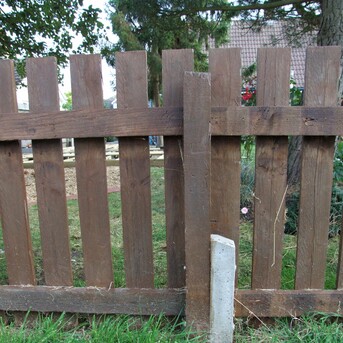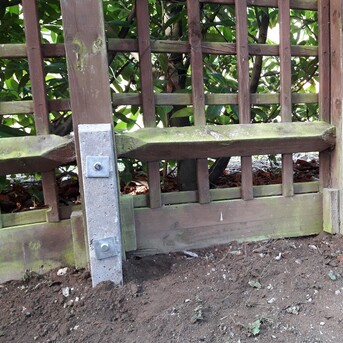Fencing Repairs
Any timber fencing, panels, picket, closeboard etc, is always subject to the elements. Any timber fence post installed into the ground is always likely to rot and break at some point in time. Regular fencing maintenance can help prolong the life of your garden fence and is worth the modest investment of time and material. Not only will the fence look better, maintaining an aesthetic appeal but the timber will survive longer.Broken timber fence posts: More information on Fencing maintenance can be found here.
Concrete repair spurs:
Often the best repair for a broken fence post is fitting a concrete spur post. If the attached fence panels are still connected and themselves in salvageable condition then fitting spur posts is usually the best and most economic solution. The process is achieved by excavating down the side of the post, breaking away the concrete foundation and fitting the new spur post. This post is either coach screwed or bolted to the solid timber above ground level and is then itself re-concreted.It essential that the spur post is installed correctly to the depth of at least the existing timber post, an absolute minimum is 45cm (18” in old money!) but usually 60cm (2’) is the correct depth. The repair spur must also sit hard against the post you are repairing so that the fixings install correctly. Once the repair spur has been fitted you can then pour new concrete into the void. In most cases the amount of concrete required is approximately two thirds or three quarters of the depth of the hole. And it needs to be at the bottom of the hole not as a collar around the top. The major structural integrity of any fence is the depth in the ground of the supporting fence posts, if these are not in far enough to support the height of the fence it will fall over!
Fencing storm damage:
Often the result of high winds (and occasionally accidents) when several sections of closeboard or fence panels have come down, fitting repair spurs may not offer the best option. Replacing ‘like for like’ fencing will often be the easiest and most economic option in this situation. At this point it is worth considering the state of the remaining upright fencing. As unpleasant as it may be, if part of the fence has failed due to rotten fence posts and the rest of the fencing was installed at the same time, the remaining posts may be in poor condition.
There is a very simple method to check this, go and give them a reasonable shove, if the posts crack or fall over then they are no good! Solid and not moving they should be OK.
Old Fencing – Repair or Replacement:
Like many other components of your property (windows, fascias, etc) fencing will get old and ultimately will need to be replaced. The problems are obvious in some cases; it is simply falling over or falling apart in other cases the problems are not always apparent on first viewing and sometimes maintenance work on the fence can prolong it’s life. This can involve replacing all the post caps and panel caps if they are present. This often helps prevent water ingress into the grain of the timber and protects the post and panel from rot and decay.It is also worth not underestimating the effects of the damage caused by UV (sunlight) to the fence.
Certainly for timber fencing this can be offset by a routine application of wood preservative treatment if not on an annual basis certainly every couple of years. This can be time consuming but is a relatively easy job and well within the realms of most ‘DIY capable’ folk.
My personal experience suggests that oil or spirit based products offer the best protection though these are less common now than they used to be for ecological reasons. I have used brands such as Barretine, Cuprinol, Sadolin and Osmo and been happy with them all. There are others to consider as well and don’t forget you can obtain Creocote a solution similar to the old fashioned Creosote that was inexpensive and very effective for treating outdoor timber and fencing.
New Fencing - Is it worth it:
You need to weigh up the value to yourselves as to whether or not some repair and maintenance to an old fence or replacement with new fencing will offer the best option. Consider what the fencing does for you, privacy or security? May be both, other factors may be how long you plan to stay in the house, are you selling up for example within the next 12 months or are you planning to get a large dog that will roam the grounds? It is also worth considering the needs of your neighbours and of course you may have to comply with local planning regulations regarding the replacement and alignment of new fences.



